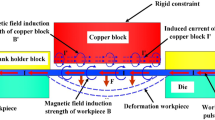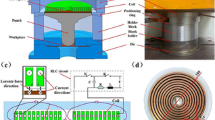Abstract
Pulsed electromagnetic forming is based on high-voltage discharge of capacitors through a coil. An intense transient magnetic field is generated in the coil and through interaction with the metal work-piece; pressure in the form of a magnetic pulse is built up to do the work. Data on formability of two aluminum alloys employed for exterior (6111-T4) and interior (5754) automotive body panels will be shown. Comparison of traditional Forming Limit Diagrams obtained by stretching of aluminum sheet with hemispherical punch to the results on formability, where hemispherical punch is replaced by a coil will be provided. It will be shown that material formability in high-rate forming conditions can significantly depend upon interaction with the forming die: electromagnetic forming into an open round window provides only slight improvement in formability, while forming in a V-shape die or into a conical die indicates a significant improvement. An important part of the electromagnetic forming technology is the design of the coil. The coil failure modes and measures preventing them are discussed.

















Similar content being viewed by others
References
J.C. Benedyk, Superplastic Forming of Automotive Parts from Aluminum Sheet at Reduced Cycle Times. Light Metal Age. 60(6) 2002, 28–31
S. Golovashchenko, A. Krause Improvement of Formability of 6xxx Aluminum Alloys Using Incremental Forming Technology. J. Mater. Eng. Perform. 14(4) 2005, 503-507
B. Avitzur Handbook of Metal Forming Processes. John Willey & Sons. New York, 1983, 1020
P. Kapitsa A Method for Producing Strong Magnetic Fields. Proc. Roy. Soc., Ser. A 105, 1924, 691-710
S.F. Golovashchenko, Numerical and Experimental Results on Pulsed Tubes Calibration, Proceedings of a 1999 TMS Symposium “Sheet Metal Forming Technology”, San-Diego, 1999, p 117–127
S.F. Golovashchenko, Springback Calibration Using Pulsed Electromagnetic Field, Proceedings of the 6th International Conference and Workshop on Numerical Simulation of 3D Sheet metal Forming Processes Numisheet 2005, Detroit, Michigan, 2005, p 284–285
S.F. Golovashchenko, V. Dmitriev, P. Canfield, A. Krause, and C. Maranville, Apparatus for Electromagnetic Forming with Durability and Efficiency Enhancements, US Patent Application US2006/086165A1, April 27, 2006
J.M. Imbert, S.L. Winkler, M.J. Worswick, D.A. Oliveira, S.F. Golovashchenko The effect of Tool-Sheet Interaction on Damage Evolution in Electromagnetic Forming of Aluminum Alloy Sheet, Transactions ASME. J. Eng. Mater. Technol. 2005, 127(1) 145-153
V.S. Balanethiram, G.S. Daehn Hyperplasticity: Increased Forming Limits at High Workpiece Velocity. Scripta Metall. Mater. 30 (1994), 515-520
Author information
Authors and Affiliations
Corresponding author
Rights and permissions
About this article
Cite this article
Golovashchenko, S.F. Material Formability and Coil Design in Electromagnetic Forming. J. of Materi Eng and Perform 16, 314–320 (2007). https://doi.org/10.1007/s11665-007-9058-7
Received:
Revised:
Published:
Issue Date:
DOI: https://doi.org/10.1007/s11665-007-9058-7




